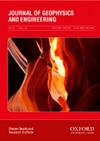基于广义极大极小凹惩罚稀疏表示的鲁棒地震衰减补偿
IF 1.7
3区 地球科学
Q3 GEOCHEMISTRY & GEOPHYSICS
引用次数: 0
摘要
摘要深层油气资源越来越受到人们的重视。然而,由于受长距离传播和地层吸收的影响,深层地震资料普遍存在能量弱、分辨率低、信噪比低等问题,严重影响了地震解释的可靠性。一般采用逆Q (quality factor)滤波(IQF)进行吸收补偿,但同时也会放大噪声。虽然基于反演的补偿方法克服了不稳定性,但仍然难以获得高信噪比的结果。针对这一问题,在稀疏表示理论框架下,提出了一种基于广义极大极小凹惩罚函数约束的单通道衰减补偿方法。采用改进的Kolsky模型描述地震吸收,结合稀疏表示理论建立目标函数。此外,利用GMC惩罚函数来提高稀疏性。它可以从受噪声污染的地震数据中更准确地估计稀疏系数。尽管GMC惩罚本身是凹的,但目标函数仍然是严格凸的。因此,可以通过算子分裂算法获得全局最优稀疏解。即使在存在噪声的情况下,该方法也能通过重构得到稳定、准确的补偿结果。综合数据测试和现场地震资料应用表明,该方法对噪声具有较高的鲁棒性。它可以稳定有效地补偿地震资料的能量损失,同时保持较高的信噪比。本文章由计算机程序翻译,如有差异,请以英文原文为准。
Robust Seismic Attenuation Compensation Based on Generalized Minimax Concave Penalty Sparse Representation
Abstract Deep hydrocarbon resources have become more and more important nowadays. However, owing to the affection of long-distance propagation and stratigraphic absorption, seismic data coming from deep beds generally suffer from weak energy, low resolution, and low signal-to-noise ratio (SNR), which seriously influence the reliability of seismic interpretation. Generally, inverse Q (quality factor) filtering (IQF) is used for absorption compensation, but it may amplify noise at the same time. Although compensation methods based on inversion overcomes the instability, it is still difficult to obtain high-SNR results. To address this issue, under the framework of sparse representation theory, we proposed a single-channel attenuation compensation method constrained by generalized minimax concave (GMC) penalty function. It takes the modified Kolsky model to describe seismic absorption and combines sparse representation theory to create objective function. Furthermore, a GMC penalty function is utilized to promote sparsity. It allows more accurate estimates of sparse coefficients from noise-contaminated seismic data. Although the GMC penalty itself is concave, the objective function remains strictly convex. Therefore, globally optimal sparse solutions can be obtained through an operator-splitting algorithm. Even in the presence of noise, this method can obtain stable and accurate compensation results through reconstruction. Synthetic data tests and field seismic data application showed that this method has high robustness to noise. It can stably and effectively compensate for the energy loss of seismic data, as well as maintain high SNR.
求助全文
通过发布文献求助,成功后即可免费获取论文全文。
去求助
来源期刊

Journal of Geophysics and Engineering
工程技术-地球化学与地球物理
CiteScore
2.50
自引率
21.40%
发文量
87
审稿时长
4 months
期刊介绍:
Journal of Geophysics and Engineering aims to promote research and developments in geophysics and related areas of engineering. It has a predominantly applied science and engineering focus, but solicits and accepts high-quality contributions in all earth-physics disciplines, including geodynamics, natural and controlled-source seismology, oil, gas and mineral exploration, petrophysics and reservoir geophysics. The journal covers those aspects of engineering that are closely related to geophysics, or on the targets and problems that geophysics addresses. Typically, this is engineering focused on the subsurface, particularly petroleum engineering, rock mechanics, geophysical software engineering, drilling technology, remote sensing, instrumentation and sensor design.
 求助内容:
求助内容: 应助结果提醒方式:
应助结果提醒方式:


